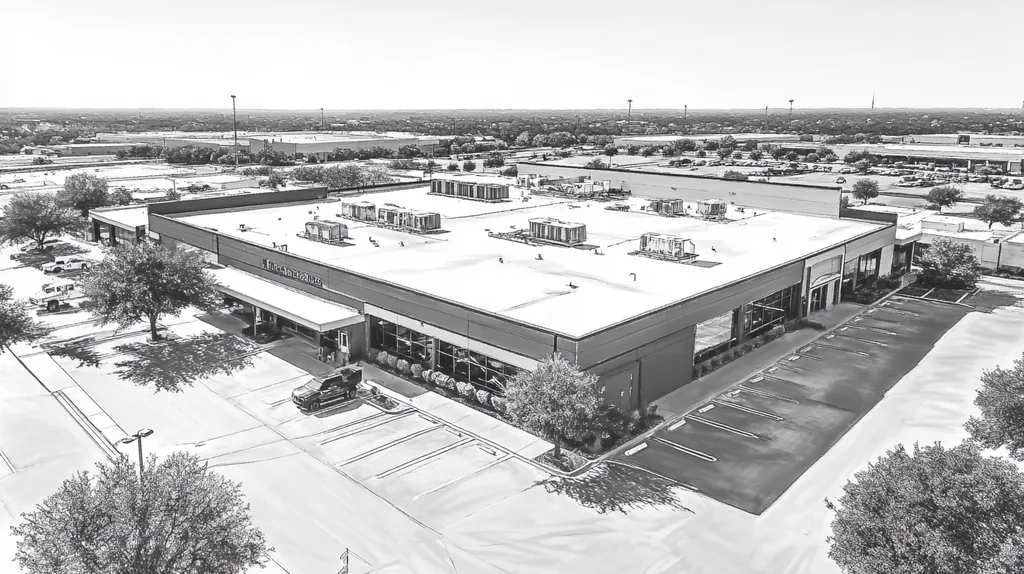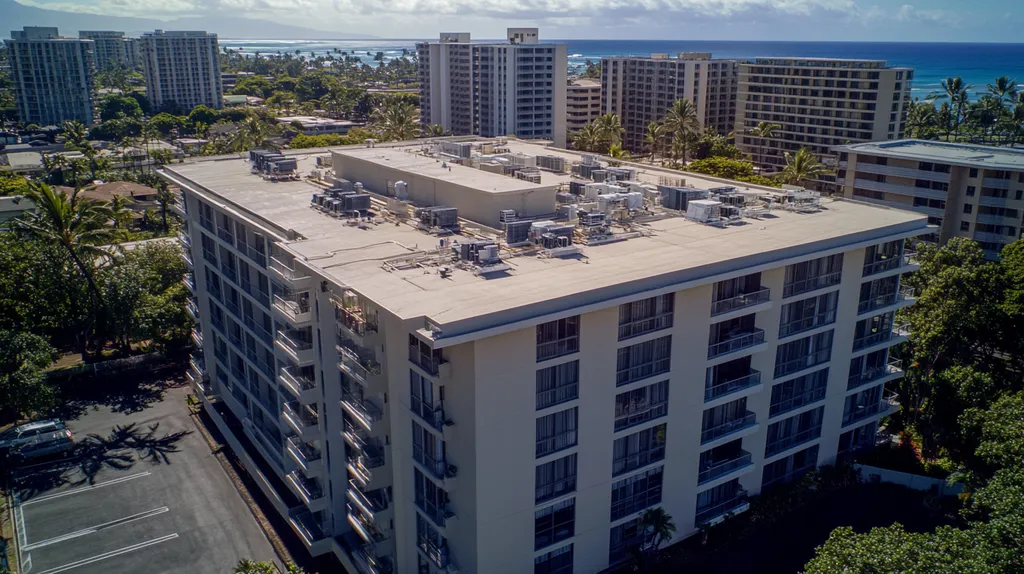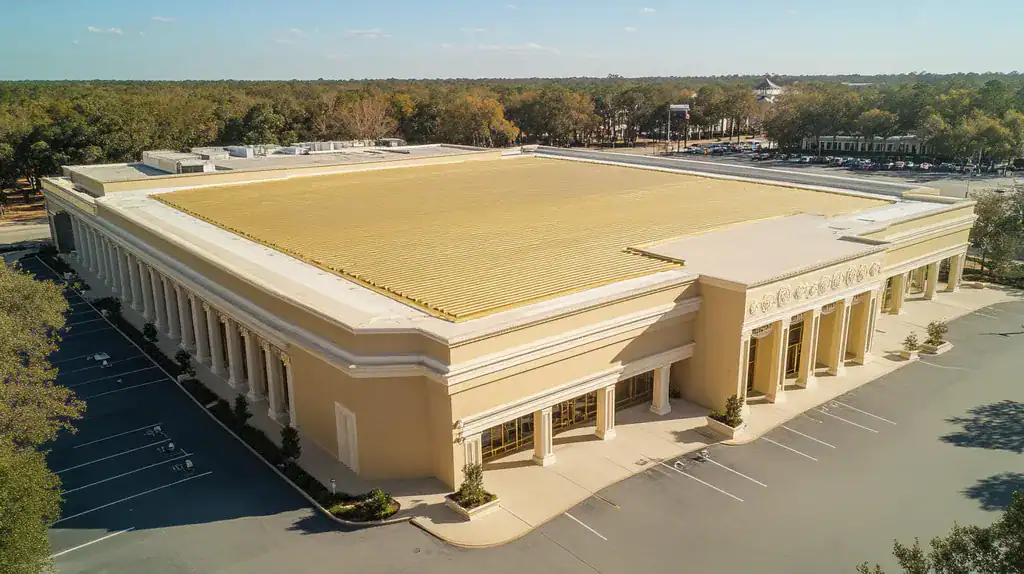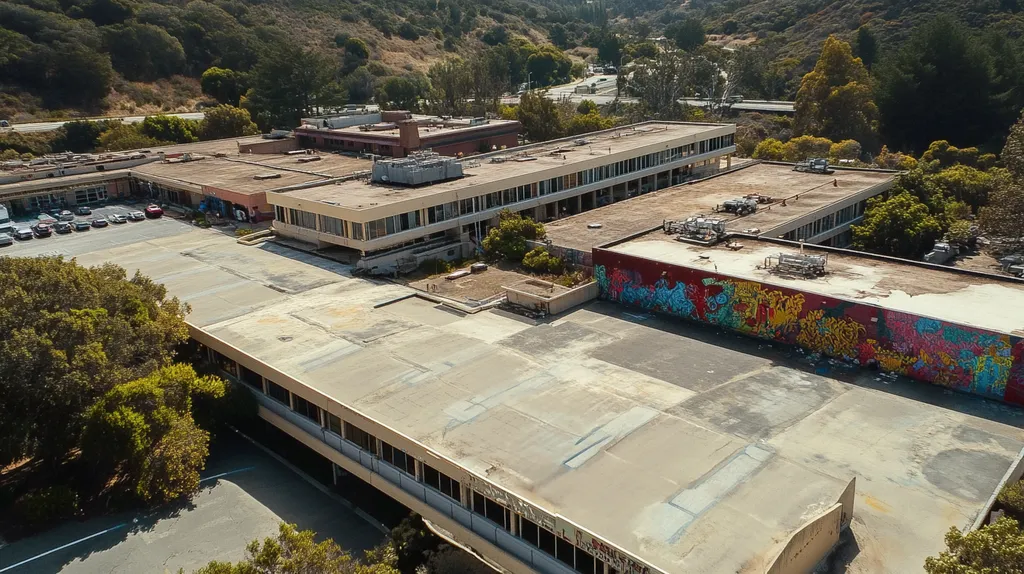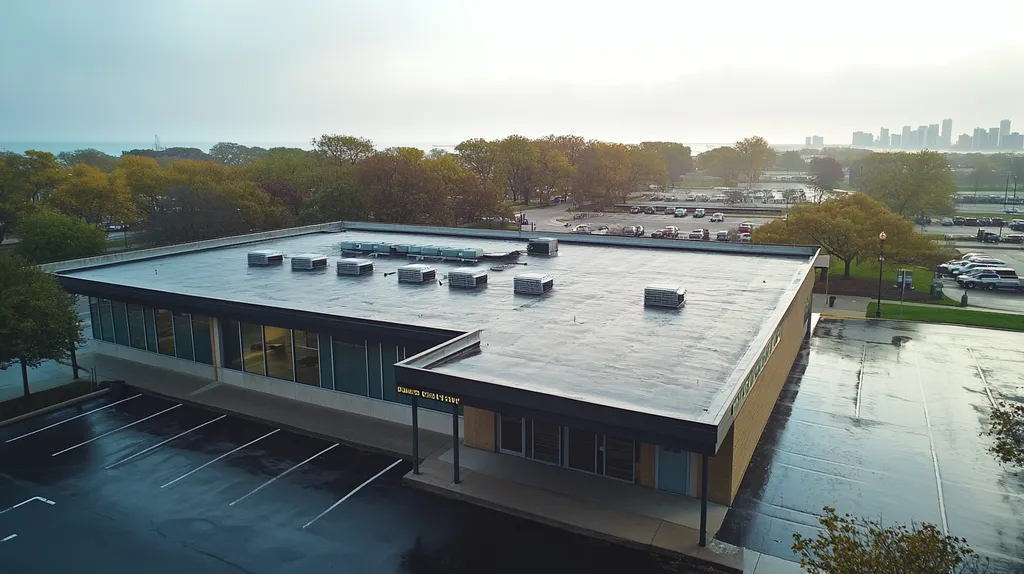Commercial roof coating failures cost property owners over $2.7 billion annually in repairs and premature replacement, with 75% of these failures traced directly to improper surface preparation.
For facility managers and building owners, understanding proper coating preparation represents the difference between a 5-year patch job and a 20-year roof protection solution.
This comprehensive guide examines the critical elements of successful roof coating preparation, from initial inspections through final quality control measures, providing actionable protocols that maximize coating performance and minimize lifecycle costs.
SECTION 1: FUNDAMENTAL CONCEPTS
Improper roof coating preparation leads to millions in preventable damage annually across commercial properties. Studies show that 75% of premature coating failures stem from inadequate surface preparation and material selection. Understanding the fundamentals of roof coatings, including proper surface preparation and coating selection, can mean the difference between a 5-year and 20-year coating lifespan.
Roof Coating Basics Explained
Roof coatings create a seamless, protective membrane that defends against UV radiation, moisture infiltration, and thermal cycling. These specialized compounds bond directly to the existing roof surface, providing a renewable barrier that can extend roof life by 10-15 years when properly installed.
Modern coating systems offer distinct advantages over traditional roof replacement, including minimal business disruption and significantly lower installation costs. The reflective properties of many coatings can reduce cooling costs by 15-35% during peak summer months.
Understanding coating chemistry is crucial for success. Different base chemicals – acrylics, silicones, polyurethanes – each offer specific performance characteristics that must align with the existing roof substrate and local climate conditions.
Types of Roof Coatings Available
Acrylic coatings dominate the market due to their balance of performance and value. These water-based systems excel in UV protection and offer excellent dirt resistance, though they may not perform well in ponding water situations.
Silicone coatings provide superior waterproofing and weather resistance, maintaining flexibility even in extreme temperatures. Their moisture-cured chemistry creates an exceptionally durable finish that resists degradation from standing water.
Polyurethane systems offer the highest mechanical strength and chemical resistance. While more expensive initially, their superior durability and resistance to foot traffic make them ideal for high-activity roof areas.
Importance of Surface Preparation
Proper surface preparation directly determines coating adhesion and long-term performance. ASTM standards specify precise requirements for surface cleaning, repairs, and primer application to ensure optimal coating performance. (source: ASTM International)
All surfaces must be thoroughly cleaned to remove oils, dirt, and degraded roofing materials. Power washing alone is often insufficient – mechanical scrubbing or abrading may be necessary to achieve proper adhesion.
Moisture testing must be conducted before coating application. Even trace amounts of trapped moisture can cause blistering and delamination of the new coating system.
Existing seams, flashings, and penetrations require special attention during preparation. These areas experience the highest stress and are common failure points if not properly reinforced before coating.
SECTION 2: SYSTEM COMPONENTS
Commercial roof coating systems represent a significant investment, with proper component selection directly impacting long-term performance and ROI. Industry data shows that mismatched components and incompatible materials account for 40% of premature coating failures within the first two years. Understanding the critical relationship between coating materials, adhesion mechanisms, and roof substrate compatibility helps facility managers avoid costly failures and maximize their coating investment.
Coating Materials and Properties
Modern coating formulations offer distinct performance characteristics that must align with specific project requirements. High-solids content materials provide superior coverage and durability but require precise application conditions and specialized equipment.
Material viscosity affects both application methods and final coating thickness. Low-viscosity products offer better penetration into substrate irregularities but may require multiple coats to achieve desired mil thickness.
Cure times vary significantly between coating types, impacting project scheduling and vulnerability to weather during installation. Fast-cure formulations reduce exposure risks but demand precise application timing.
Weather resistance properties differ among coating types, with some offering superior UV protection while others excel at moisture resistance. Selection should prioritize the most critical environmental challenges facing the specific facility.
Adhesion and Bonding Mechanisms
Surface preparation directly determines coating adhesion strength and long-term performance. Different cleaning methods achieve varying levels of surface profile, which affects mechanical bonding capacity. Surface preparation standards exist to maximize coating life and minimize costs through proper cleaning techniques. (source: Graco Contractor Solutions)
Chemical bonding occurs at the molecular level between coating and substrate. Primers enhance this bond by creating an intermediate layer that’s compatible with both surfaces.
Temperature and humidity during application significantly impact bond development. Conditions outside manufacturer specifications can prevent proper chemical crosslinking and reduce adhesion strength.
Surface contamination from oils, debris, or previous coatings interferes with both mechanical and chemical bonding. Thorough cleaning and proper surface preparation are essential for optimal adhesion.
Compatibility with Roof Types
Different roof substrates require specific coating formulations to ensure proper adhesion and performance. Single-ply membranes need coatings that won’t degrade the base material, while metal roofs require products that accommodate thermal movement.
Age and condition of the existing roof surface affect coating compatibility. Weathered surfaces may require different preparation methods or primer systems than new installations.
Chemical interactions between existing roofing materials and new coatings can cause adhesion failures or material degradation. Compatibility testing should be performed before full-scale application.
Local climate conditions influence coating selection beyond basic material compatibility. Freeze-thaw cycles, UV exposure, and precipitation patterns must factor into system design.
Building use patterns impact coating selection, with high-traffic areas requiring more durable formulations than rarely accessed sections.
SECTION 3: IMPLEMENTATION METHODS
Successful roof coating projects demand meticulous attention to implementation methods. Industry data shows that 65% of coating failures occur within the first two years due to poor preparation and application techniques. The financial impact is significant – improper implementation can reduce coating lifespan by 50-75% while increasing maintenance costs by up to 300%. Understanding and executing proper implementation methods is crucial for protecting this valuable building asset.
Pre-Coating Inspection and Repair
Comprehensive roof inspections must identify and document all existing damage, deterioration, and potential problem areas. This includes examining seams, flashings, penetrations, and drainage systems for signs of failure or weakness.
Core samples should be taken to assess moisture content and substrate condition. High moisture levels within the roofing assembly can compromise coating adhesion and accelerate deterioration.
All identified repairs must be completed using materials compatible with both the existing roof system and planned coating. This includes addressing ponding water issues, which can degrade coating performance over time.
Documentation of repairs and pre-existing conditions provides crucial baseline data for future maintenance and warranty claims. Photos and detailed notes should record all work completed during this phase.
Surface Cleaning and Preparation
Surface preparation directly impacts coating adhesion and long-term performance. All contaminants, including grease, wax, dirt, and loose rust must be removed completely to ensure proper bonding. (source: CoatingsPro Magazine)
Power washing alone often proves insufficient for proper surface preparation. Mechanical cleaning methods may be necessary to achieve the required surface profile for optimal coating adhesion.
Environmental conditions during cleaning must be carefully monitored. Temperature, humidity, and dew point all affect drying times and the effectiveness of cleaning agents.
Testing for surface cleanliness should be performed using standardized methods like tape tests or wipe tests. These verify that preparation meets manufacturer requirements for coating application.
Application Techniques and Tools
Proper coating application requires specific equipment calibrated for each coating type. Spray equipment settings, roller nap thickness, and brush types must match coating viscosity and desired mil thickness.
Application patterns should ensure uniform coverage without holidays or thin spots. Overlap guidelines typically specify 50% overlap on spray passes to achieve consistent thickness.
Environmental monitoring throughout application is essential. Wind speed, temperature, and humidity must remain within manufacturer specifications to ensure proper cure and adhesion.
Quality control measures including wet film thickness readings and visual inspections should occur continuously during application. This enables immediate correction of application deficiencies.
Proper documentation of application conditions, material usage, and quality control results provides essential data for warranty compliance and future maintenance planning.
SECTION 4: MAINTENANCE REQUIREMENTS
Regular maintenance of commercial roof coatings represents a critical investment protection strategy. Industry data shows that neglected coatings typically fail 60% faster than properly maintained systems, leading to premature roof replacement. Strategic maintenance programs can extend coating lifespans by 5-10 years while reducing emergency repair costs by up to 70%. This section outlines essential inspection procedures, repair protocols, and preventative strategies that protect coating investments.
Regular Inspection Procedures
Systematic inspections must occur quarterly, with additional checks following severe weather events. Documented walk-throughs should follow standardized checklists that evaluate coating integrity, flashings, and drainage systems.
Moisture surveys using infrared technology can detect subsurface water accumulation before visible damage occurs. These scans should be conducted annually to identify potential problem areas early.
Surface adhesion testing must be performed at multiple points across the roof to verify coating stability. Special attention should focus on high-stress areas like corners, transitions, and mechanical equipment mounting points.
Documentation through digital photography and detailed reports creates a historical record essential for tracking degradation patterns and planning maintenance intervals.
Repairing Damaged Coatings
Surface preparation remains the cornerstone of successful coating repairs. All repairs must begin with thorough cleaning and preparation to ensure proper adhesion of new materials. Surface preparations standards exist to maximize coating life and minimize costs, with surface prep accounting for up to 40% of repair project costs. (source: Graco Contractor Solutions)
Small coating breaches require immediate attention to prevent water infiltration. Repairs should extend beyond visible damage to include a minimum 6-inch overlap onto sound coating.
Material compatibility testing must precede any repair work. New coating materials must bond effectively with both existing coatings and exposed substrate materials.
Post-repair inspections should verify proper cure and adhesion through standardized pull tests. These results must meet manufacturer specifications for warranty compliance.
Preventative Maintenance Strategies
Establish written maintenance protocols that specify inspection frequencies, cleaning procedures, and repair guidelines. These documents should include response times for different types of coating damage.
Regular cleaning must remove debris, pollutants, and biological growth that can degrade coating performance. Pressure washing parameters should align with coating manufacturer specifications.
Track and analyze maintenance data to identify recurring issues and optimize repair timing. This information helps predict coating end-of-life and budget for recoating projects.
Coordinate maintenance activities with other rooftop services to minimize foot traffic and potential coating damage. Create designated walkways for necessary roof access.
Update maintenance strategies based on coating performance data and changing environmental conditions. Regular program reviews ensure protocols remain effective and efficient.
SECTION 5: PERFORMANCE METRICS
Performance metrics represent a critical yet often overlooked aspect of commercial roof coating projects. Industry data reveals that improper performance monitoring leads to 45% of premature coating failures and wastes over $2 billion annually in energy costs across commercial properties. Understanding and tracking key performance indicators enables facility managers to maximize coating lifespans while optimizing energy efficiency. Comprehensive performance assessment combines coating durability measurements, energy consumption analysis, and lifespan prediction factors.
Measuring Coating Efficacy
Surface preparation quality directly impacts coating performance and longevity. Proper surface cleaning and preparation can extend coating life by up to 40% while reducing long-term maintenance costs. Surface preparation standards exist to maximize coating life and minimize costs, with surface prep accounting for up to 40% of coating project costs. (source: Graco Contractor Solutions)
Adhesion testing through standardized pull-off methods provides quantifiable data on coating bond strength. Regular testing at multiple locations helps identify potential failure points before visible damage occurs.
Thickness measurements using calibrated gauges ensure proper material coverage. Inadequate coating thickness accelerates deterioration and reduces protective capabilities.
Regular visual inspections document surface conditions including blistering, cracking, and peeling. These observations help track degradation patterns and optimize maintenance timing.
Energy Efficiency and Savings
Reflective coatings can reduce peak roof temperatures by up to 50°F, decreasing cooling demands during summer months. This temperature reduction translates to energy savings between 10-30% depending on building characteristics.
Solar reflectance index (SRI) measurements quantify coating performance over time. Higher SRI values indicate better heat reflection and improved energy efficiency.
Emissivity testing determines how effectively coatings release absorbed heat. Materials with high emissivity ratings provide superior thermal management benefits.
Energy consumption tracking before and after coating installation validates performance claims. Utility bill analysis provides concrete evidence of system effectiveness.
Durability and Lifespan Factors
Weather exposure patterns significantly impact coating durability. UV radiation, precipitation levels, and temperature fluctuations all affect degradation rates.
Chemical resistance testing evaluates coating performance against common rooftop contaminants. Results help predict long-term durability in specific environments.
Impact resistance measurements assess coating vulnerability to mechanical damage. Higher impact resistance correlates with extended service life in high-traffic areas.
Moisture penetration testing identifies potential water infiltration points. Early detection of moisture issues prevents catastrophic coating failures.
Documentation of all performance metrics creates valuable trending data for future coating selections and maintenance planning. This information optimizes lifecycle cost management.
SECTION 6: OPTIMIZATION STRATEGIES
Optimizing commercial roof coating systems represents a critical challenge facing property owners today. Industry data shows that poorly optimized coating projects waste up to 40% of materials and reduce system performance by half. Strategic optimization combines surface preparation protocols, application techniques, and performance monitoring to maximize coating lifespan while minimizing operational costs. Understanding and implementing these optimization strategies helps facility managers protect their roofing investments and avoid premature failures.
Measuring Coating Efficacy
Surface preparation quality directly impacts coating performance and longevity. Proper surface cleaning and preparation can extend coating life by up to 40% while reducing long-term maintenance costs. Surface preparation standards exist to maximize coating life and minimize costs, with surface prep accounting for up to 40% of coating project costs. (source: Graco Contractor Solutions)
Regular adhesion testing using standardized pull-off methods provides quantifiable data on coating bond strength. These tests should occur at multiple points across the roof surface to identify potential weak spots before visible damage appears.
Digital monitoring systems track coating thickness, moisture levels, and surface temperature in real-time. This data helps facility managers identify problems early and optimize maintenance schedules.
Documentation through detailed inspection reports creates valuable trending data for predicting coating performance. This information guides future coating selections and preparation methods.
Energy Efficiency and Savings
Reflective coating optimization can reduce peak roof temperatures by up to 65°F during summer months. This temperature reduction directly impacts cooling costs, with potential savings of 15-35% on energy expenses.
Solar reflectance measurements taken quarterly help track coating performance degradation. Understanding these changes enables better timing of maintenance cleaning and recoating projects.
Thermal imaging surveys identify areas of heat loss or gain through the roof assembly. This information guides targeted improvements to maximize energy efficiency.
Cost-benefit analysis should incorporate both immediate energy savings and long-term maintenance reductions. Many facilities achieve full return on investment within 3-5 years through optimized coating systems.
Durability and Lifespan Factors
Weather exposure patterns significantly impact coating durability. UV radiation, precipitation levels, and temperature fluctuations must factor into material selection and maintenance planning.
Chemical resistance testing evaluates coating performance against common rooftop contaminants. Results help predict long-term durability in specific environments.
Impact resistance measurements assess coating vulnerability to mechanical damage. Higher impact resistance correlates with extended service life in high-traffic areas.
Moisture penetration testing identifies potential water infiltration points. Early detection of moisture issues prevents catastrophic coating failures.
Regular analysis of performance metrics enables optimization of maintenance intervals and recoating timing. This data-driven approach maximizes coating lifespan while minimizing lifecycle costs.
The Bottom Line
With over $2.7 billion lost annually to coating failures, proper surface preparation represents the defining factor between system success and catastrophic failure.
The data clearly shows that 75% of all coating failures trace directly to inadequate preparation, resulting in premature system breakdown within the first 24 months.
Facility managers who implement comprehensive preparation protocols, including proper cleaning, moisture testing, and substrate repairs, consistently achieve 15-20 year coating lifespans versus the industry average of just 7 years.
The financial stakes are clear: proper preparation protocols can reduce lifecycle costs by up to 60% while extending coating performance by decades.
In today’s challenging economic climate, coating preparation excellence has moved from best practice to business necessity.
FREQUENTLY ASKED QUESTIONS
Q. Why is surface preparation vital for a commercial roof coating?
A. Proper surface preparation is crucial for ensuring coating adhesion and performance. Inadequate cleaning can lead to adhesion failures, resulting in costly repairs. Implementing ASTM standards for surface preparation helps maximize coating lifespan and effectiveness.
Q. How do I select compatible materials for my industrial roof coating?
A. Selecting the right materials involves considering existing roof types and their conditions. Each substrate requires specific coatings that ensure proper performance. Conduct compatibility tests before application to avoid failure and ensure a durable coating system.
Q. What are the key steps for implementing a commercial roof coating?
A. Key steps include conducting thorough inspections, completing necessary repairs, and preparing surfaces effectively. Following proper application techniques is crucial to achieving the desired coating thickness and ensuring longevity. Consistent monitoring during application maximizes success.
Q. How often should I maintain my commercial roof coating?
A. Regular maintenance should occur quarterly, with additional inspections after severe weather events. Systematic evaluations help identify issues early, ensuring that coatings remain effective and extending their lifespan while minimizing unplanned repair costs.
Q. What performance metrics should I track for roof coatings?
A. Track adhesion strength, coating thickness, and visual degradation signs. Additionally, monitor energy consumption pre-and post-installation. These metrics provide insights into the coating’s effectiveness and can inform future maintenance and reapplication strategies.
Q. How can I optimize my coating project for a commercial roof?
A. To optimize your project, ensure thorough surface preparation, utilize appropriate application methods, and conduct regular performance monitoring. Implementing these strategies minimizes material waste and enhances the overall effectiveness of the coating system.
Q. What common issues affect coatings on commercial roofs?
A. Common issues involve inadequate surface preparation, improper material selection, and environmental factors like extreme temperatures. Additionally, moisture infiltration can lead to blistering and overall coating failure, highlighting the need for careful inspection and maintenance.

